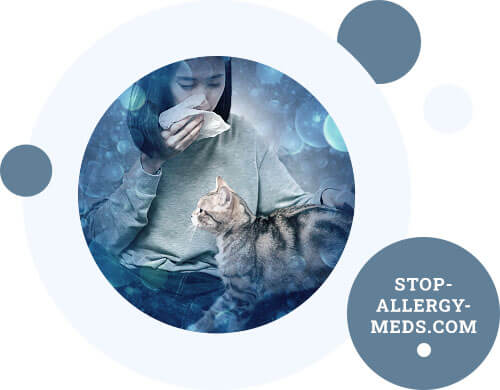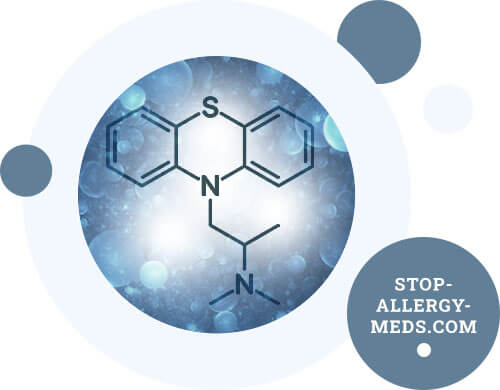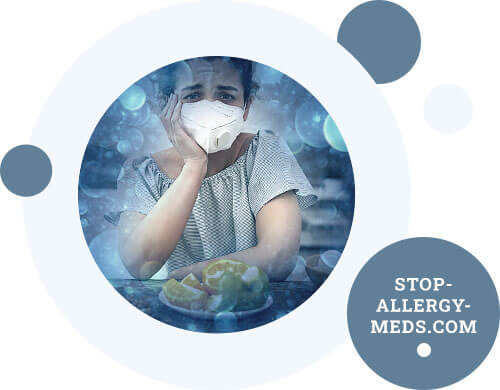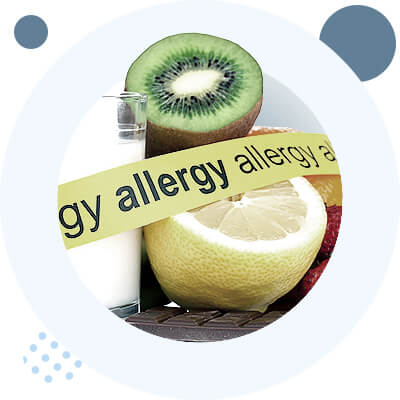Allergy
Allergy is a hypersensitivity of the body to various substances - allergens, manifested by symptoms of allergic disease. Up to 25% of the population of industrial areas suffers from some kind of allergic disease. The number of cases of allergy and its severity is steadily growing all over the world.
An allergy is a state of hypersensitivity of a living organism, in relation to a certain substance or substances (allergens), which develops with repeated exposure to these substances. The physiological mechanism of allergy is the formation of antibodies in the body, which leads to a decrease or increase in its sensitivity. Allergy is manifested by severe irritation of the mucous membranes, skin rashes, general malaise, etc.
Allergic diseases are hyperreactions of the body in response to environmental factors, which they take as potentially dangerous (even if in reality they are not). Naturally, if there are "hyperreactions", that is, normal reactions. Normal reaction is the development of a normal immune response.
The mechanism of immune response is very complex. It involves the production of antibodies, which are the "protectors" of the body. The task of antibodies is to neutralize the invaded substances (so-called "antigens"). Theoretically, any immune reaction must be successful. But sometimes the immune system as if "exceeds its powers" and, having lost control, begins to react to a completely harmless substance as a dangerous one. This loss of control leads to the triggering of destructive hyper-reactions (allergies).
Among the numerous allergens are: domestic (house dust, daphnia), epidermal (dandruff and animal hair, feathers, fish scales), insect poison allergens, food, medicinal, infectious, industrial, pollen. Clinical manifestations are very diverse and the degree of severity depends on many reasons. The pathological process can involve virtually all body systems.
The concept of "allergy" was introduced in 1906 by Pirke to characterize changes in the reactivity of the body. The introduction of this concept, which gave rise to a new science - allergology, was due to a number of observations from experimental immunology and clinical pathology. In addition to anaphylaxis and immunity, Pirke established the concept of general and local low and high sensitivity, combining all these conditions into one group of reactivity manifestations - allergies.

The term "allergy" comes from two Greek words: "allos" - "other", "other" and "ergone" - "action". In modern science, the term "allergy" refers to a pathological condition characterized by an increased (hyperergic) and qualitatively altered reaction of the body in response to repeated penetration into the body of substances of antigenic nature (allergens).
The term allergy was first introduced by the Austrian pediatrician K. Pirke in 1906. It comes from two Greek words: allos - different and ergon - action. Allergies are talked about when the immune system comes into action and the body responds with a rapid reaction and exaggerated protection to substances that in themselves are quite harmless. In other words, an allergy is a hypersensitivity, a changed response of the human body to certain factors (in this case they are called allergens).
The high prevalence of allergic diseases (more than 20% of the world's population) suggests that allergies are a global medical problem. In the last 30 years, the prevalence of allergic diseases has doubled every decade, and nowadays at least 5% of adults and 15% of children suffer from various types of allergies.
One of the main allergy "culprits" is histamine. Molecules of this and similar substances in large quantities are thrown into the blood, when, for example, plant pollen provokes an immune reaction. The result - "obvious": vasodilation, the release of fluid from small vessels, redness of the skin. This causes irritation of the mucous membranes of the nasopharynx, starts a runny nose and sneezing.
The nature of allergy remains a mystery in many ways. An allergy can occur unexpectedly and also pass unexpectedly (unfortunately, the former occurs much more often than the latter). In addition, the predisposition to this or that kind of allergy is inherited (atopy), so if one of the parents suffers from an allergy, there is a 25% probability that his child will develop an allergy. The chance of getting an allergy increases to 75-80% if both parents suffer from an allergy.
An allergy in itself is a very unpleasant condition. Strong runny nose, swelling, red itchy eyes... Many allergic people can't even go outside - it gets worse there, they close all the windows and stay at home for a few weeks. Allergies increase fatigue, increase irritability, reduce immunity. Allergies can provoke diseases such as eczema, hemolytic anemia, serum disease, bronchial asthma. The most serious manifestation of an allergy is anaphylactic shock: difficulty breathing, convulsions, loss of consciousness, a significant decrease in blood pressure, up to death. Fortunately, anaphylactic shock as an allergic reaction to airborne allergens is very rare, it is more likely to be caused by the introduction of certain drugs, insect bites, less likely food allergens.
The main thing to prevent and treat the allergy is to identify its cause, the allergen that causes all the unpleasant consequences. But, firstly, it is not always possible to "calculate" the culprit of the allergy, and secondly, it is often simply impossible to get rid of it. In addition, any manifestation of an allergy is a signal that not everything is safe in your immune system, which means that even if you completely get rid of the "your" allergen, you can not be sure that tomorrow the same thing will not start because of something else.
This disease is one of the most common on Earth. According to statistics, already today every fifth inhabitant of our planet suffers from it: every sixth American, every fourth German, from 5 to 30% of Russians, 17% of Muscovites. International statistics shows that over the past two decades, the incidence of allergies has increased by 3-4 times, and the disease often occurs in a severe, unusual form. This is due to an increase in allergenic load on a person.
Deteriorating environmental situation, unsustainable diet, excessive drug therapy, uncontrolled use of antibiotics, stress, sedentary lifestyle, changes in the climate ... All this increases the exposure of the human body to allergens - even those that have always existed.
And if the XX century was the century of cardiovascular disease, the XXI century is predicted by the World Health Organization will be the century of allergies. Diseases, which we now call allergic, have been known for a long time. Doctors of Ancient Egypt at one time already noticed symptoms that are similar to allergies. But humanity paid attention to allergies only in the XIX century, and understood the nature of this phenomenon only by the end of XX century.
Allergy is defined by immunologists-allergists as an unusual reaction of the immune system to a common phenomenon. For a person predisposed to the disease, everything that surrounds him can become an allergen: household dust, pollen, pet hair, medicines, food and household chemicals.
The difficulty in treating this disease is also that the so-called single-component allergy is extremely rare. As a rule, a person who is able to develop an allergic reaction to one of the allergens is also able to develop it to the other allergens listed above. Specialists also have the concept of "cross-allergy," which is based on an interesting phenomenon: if one allergen is known, it is easy to identify a group of plants and food that will also act as allergens.
The wormwood example is significant. If you are allergic to it, then wait for a similar reaction to dahlias, chamomile, dandelion, sunflower, citrus, succession, sunflower oil... Such knowledge can only be obtained through a consultation with a specialist. And to know this is necessary at least in order not to bathe a child who is allergic to wormwood, in a succession of chamomile, and exclude from its diet seeds.
Types of allergies
Respiratory allergy is usually caused by very small allergens present in the air - air allergens (plant pollen, animal hair and dander particles, spores of mold fungi, fragments of mites of house dust and cockroaches). Bronchial asthma - the name of the disease comes from the Greek word - asthma (heavy breathing). The main manifestations of the disease are asphyxiation, cough and wheezing. Allergic dermatoses are allergic skin diseases. Anaphylactic shock is the most unfavorable variant of allergic reaction. One of the most frequent causes of anaphylactic shock is allergy to insects; anaphylactic shock develops after stinging by membrane insects - wasps, bees and hornets. Another frequent cause of anaphylactic shock is a drug allergy - to antibiotics, analgesics and many other drugs.
About "modern" allergy treatment methods
In the treatment of respiratory allergic diseases (pollinosis, allergic rhinitis) and conjunctivitis are most often used three groups of drugs: antihistamines, kromones and corticosteroid hormones. And for the treatment of bronchial asthma - broncholitics or bronchodilators, as well as hormones, crowns and antileukotrienes.
Antihistamines are used only to prevent the development of allergy symptoms and to relieve symptoms that already exist. Cromones (cromoglycate, necromil) are widely used in allergology as a preventive anti-inflammatory drugs. Local (topical, inhaled) corticosteroid hormones. Despite the pronounced antiallergic activity, they do not have a high enough safety. Antileukotrienovye drugs. New anti-allergic drugs for ingestion. These drugs do not belong to hormones. Although this does not reduce the negative side effects of drugs in this group. Bronchodilators or bronchodilators. These include the so-called "ambulance" drugs for rapid relief of suffocation. Glucocorticoid hormones, crowns and antileukotrienes. In contrast to drugs "ambulance", drugs "basic" therapy are prescribed for long-term prevention of asthma exacerbations. Systemic steroid hormones. In severe cases and severe exacerbations of the disease doctor may prescribe you steroid hormones in tablets or injections. Combined drug treatment. Practice shows that in most cases, one drug is not enough, especially when the manifestations of the disease are pronounced. Therefore, in order to enhance the therapeutic effect, medicines are combined.
Allergy treatment can be symptomatic and pathogenetic. The first option is antihistamines. Antihistamine drug competes with histamine for histamine receptor, blocks it and interrupts the reaction. The inflammation passes.
Antihistamines include the well-known dimedrol, pipolphin, tavegil, suprastaine, etc. These are the first generation drugs.
Now there are drugs of the second generation: kestin, claritin, zirtec. They differ from the first generation in safety, duration of action and lack of sedative (sleeping pills) action. Their effectiveness is explained by the fact that they block the receptors for a longer time (for 24 hours) without requiring multiple taking. Second-generation drugs also have no negative effect on mucous membranes.
The second option of treatment is specific immunotherapy, aimed at the mechanism of allergic reaction. It is based on the treatment of such an allergy: in seasonal allergy treatment is carried out with the allergen that causes it (pollinosis - pollen). In case of year-round allergy (for example, allergy to dust) - dust. It is carried out exclusively by an allergist.
Allergic diseases include:
- bronchial asthma
- atopic dermatitis
- chronic recurrent hives
- Queen's swelling,
- year-round and seasonal rhinitis
- drug intolerance
- food allergy.
All these diseases require consultation and observation by an allergic immunologist.
Mechanism of allergic reaction
There are several mechanisms for the development of an allergic reaction, but the most common one is of immediate type. This is an allergic reaction caused by immunoglobulin E. Immunoglobulins are special proteins that are present in the blood and secretion, and the mechanism of their action in case of allergy is as follows: in a person suffering from or predisposed to allergy, antibodies accumulate in the body, which, when combined with an antigen from the outside (allergists call it "allergen"), cause a real immune reaction "antigen-antibody". It only takes a few seconds from the moment of exposure to the development of the reaction: the patient inhaled pollen and sneezed.
The allergy has many faces. Its manifestations are very diverse. It may be inflammation of the mucous membrane of the nose (rhinitis) and eyes (conjunctivitis); swelling of the face, neck, local edema (swelling of the neck); bronchospasm with the outcome of asthma; skin rashes and itching (hives) or dermatitis (neurodermatitis).

There are two types of allergy: seasonal and year-round, which, in turn, is associated with the nature of the allergen.
Allergens constantly present in our habitat cause a year-round reaction: house dust, mold fungi living in bathrooms, kitchens and corridors of old houses, medicines, household chemicals...
Seasonal allergies are associated with the seasons and life of plants, and this helps to determine the date of exacerbation quite accurately. For example, the "dusting" (flowering) of trees falls on April-May, grasses (lawn grass including) - in June-July, and flowering complex-colored (wormwood, meadow grasses) - at the end of summer. As a rule, each patient knows exactly when to wait for symptoms to appear.
It is very important to diagnose the allergy before the crisis, so it is better to go to an allergist at the first suspicion. The following symptoms should serve as a reason for concern:
- long-term runny nose,
- itching nose and sneezing attacks,
- itchy age,
- watering,
- bloodshot eyes,
- skin rash and itching,
- edema,
- shortness of breath.
Allergists have a large arsenal of methods to identify which substance is an allergen. The main methods of diagnosis are tests and specimens, determination of total immunoglobulin and specific antibodies. There are other diagnostic procedures.
n important risk factor for allergy development is heredity. Genetic predisposition to allergic reactions plays not the least role in the development of the disease. If one of the parents is allergic, the probability of developing an allergy in a child reaches 30-40%. If both parents suffer from this disease, the risk is 70-75%. That is why it is extremely important to contact a specialist in time.
Genetics is also important to understand why sometimes allergies do not develop in a particular person, despite the fact that everyone in his family has them. Since it is not the disease itself that is inherited, but the predisposition to it, then breastfeeding a newborn infant for at least 6 months could prevent or mitigate the manifestation of allergies in the future. But, unfortunately, fewer and fewer mothers are breastfeeding their infants (in Moscow in particular, only 30%).
Immunologist-allergist issues two official medical documents: a medical report with recommendations and prognosis, and a patient passport, which indicates the allergen and an emergency plan in case of exacerbation. After all, if the patient loses consciousness, only documents work. Passport must always be with him.
Ecology and allergy
The environmental situation is directly related to the development and course of allergic disease. Let us cite one fact: in the city allergies develop 3 times more often and are much more severe than in the village.
The importance of both small and large ecology.
Allergens - pollen, plants, animals - carry all the elements of the great ecology.
Small ecology is made up of the microcosm of our mucous membranes. But the internal environment can change so much that the mucous membranes begin to reproduce microbes, which should not be there, and useful microbes that produce hormones, enzymes, vitamins, are not kept on it and die. This phenomenon is known as dysbacteriosis, although now they are already talking about mucous membrane dysbiosis, expanding this concept. It also changes for the worse the picture of an allergic disease.
An allergy to high and low temperatures is a very common phenomenon. It is a pseudoallergy. It indicates the presence of chronic foci of infection in an uncompensated state. Their treatment is simply necessary, because chronic tonsillitis, cholecystitis, intestinal dysbacteriosis contribute to the development or aggravation of a true allergy.
Under the mask of an allergy may hide a more severe disease, up to a systemic one, with the same manifestations. It may be lupus red, diseases of the gastrointestinal tract, gastric and 12 duodenal ulcer, rheumatic diseases.
Allergy in children
What should parents be concerned about?
Since the incidence of allergy depends on genetic predisposition, every child born to allergic parents should be examined by an allergic doctor as early as possible, especially if he suffers from diathesis.
Types of allergies (allergic reactions)
The first three types of allergies are acute and therefore need more invigorating interventions.
The first type of allergy (allergic reaction) is based on a reactive mechanism of tissue damage, usually involving IgE, less often than class IgG, on the surface of the membranes of basophils and mast cells. A number of biologically active substances are released into the blood: histamine, serotonin, bradykinins, gsparin, slowly reacting substance anaphylaxis, leukotrienes, etc., which lead to a violation of the permeability of cell membranes, interstitial edema, spasm of smooth muscles, increased secretion. Typical clinical examples of the first type allergy are anaphylactic shock, bronchial asthma, hives, false cereal, vasomotor rhinitis.
The second type of allergy (allergic reaction) is cytotoxic, occurring with the participation of immunoglobulins of classes O and M, as well as the activation of the complement system, which leads to damage to the cell membrane. This type of allergy is observed in drug allergy with the development of leukopenia, thrombocytopenia, hemolytic anemia, as well as in hemolysis during hemotransfusion, hemolytic disease of newborns in rhesus.
The third type of allergy (allergic reaction) is associated with tissue damage by immune complexes circulating in the bloodstream and involving class C and M immunoglobulins. The damaging effect of immune complexes on tissue occurs through activation of complement and lysosomal enzymes. This type of allergy is developed in exogenous allergic alveolitis, glomerulonephritis, allergic dermatitis, serum disease, certain types of drug and food allergies, rheumatoid arthritis, systemic lupus erythematosus, and others.
The fourth type of allergy (allergic reaction) - tuberculin, slow - occurs after 24-48 h, occurs with the participation of sensitized lymphocytes. It is typical for infectious allergic bronchial asthma, tuberculosis, brucellosis and some other diseases.
Allergies (allergic reactions) can occur at any age; their intensity varies. The clinical picture of an allergy does not depend on the chemical and pharmacological properties of the allergen, its dose and route of administration. Allergies occur more often when the allergen is reintroduced into the body, but there are known cases of anaphylactic reactions of the allergy when the antibiotic is first injected into the body without prior sensitization, so caution is needed when conducting intradermal samples.
Clinical manifestations of allergies are characterized by pronounced polymorphism. Any tissues and organs may be involved in the process. Skin, gastrointestinal tract, respiratory tract are more likely to suffer from allergies. It is common to identify immediate and delayed allergic reactions, but the division is largely arbitrary. Thus, hives are considered a form of immediate allergy, but they may accompany serum disease as a classic form of delayed allergy. Distinguishes between the following clinical allergies: local allergy, allergic toxicodermia, pollinosis, bronchial asthma, angioedema Quinque, hives, serum disease, hemolytic crisis, allergic thrombocytopenia, anaphylactic shock. In the prodromal period of any allergy there is a general malaise, poor health, headache, chills, nausea, sometimes vomiting, shortness of breath, dizziness. In an allergy, there is a skin itch, a burning sensation in the mouth and nose, a feeling of numbness, stuffy nose, continuous sneezing.
Another important prerequisite for allergization of the body and the emergence of allergic reactions from the immune system are intestinal parasites that release into the blood products of their vital functions (toxins), which may be the cause of a variety of allergic diseases.
Factors predisposing to allergies
It is now established that the predisposition to allergies is both inherited and can be acquired during life.
Factors that contribute to the development of allergies:
- hereditary: for example, in 22 pairs of chromosomes - "allergy gene"; if there is a tendency to develop atopic reactions; hereditary - acquired: these include anomalies of constitution - diathesis:
- exudative-catarrhal (propensity to ITH),
- lymphatic-hygioplastic (inclination to autoallergy);
- acquired: as a result of changes in the functions of the systems that organize reactivity:
- change in the functions of the immune system (decrease in the number or function of T-suppressors),
- change in permeability of histogematic barriers (against the background of inflammation, pyrotherapy, etc.),
- change in endocrine system functions (decrease in adrenal function, etc.).
Allergens
The substances that can cause an allergy state are called allergens. The number of allergens in nature is large, they are diverse in composition and properties. Allergens are primarily alien proteins or lipids connected to them, animal and plant mukopolysaccharides and other compounds of non-protein nature. Allergens may also be some low-molecular substances, such as iodine.
Classification of allergies
There are many allergens that occur in nature and are formed in the body, there are also manifold manifestations of allergic diseases, but the mechanism of their development has a lot in common, so the modern classification of allergy is based on their pathogenetic mechanisms. According to the adopted classification, allergic reactions can be divided into two large groups: ITH (immediate hypersensitivity) and DTH (delayed hypersensitivity).
Pathogenesis of allergic reactions
The primary penetration of an allergen into the body is most often completely invisible to the body, but this does not mean that the human body does not react in any way to the primary allergen. The period between the primary allergen in the body and the secondary allergen is called the period of sensitization ("sensibilis" in Latin means "sensitive"). During this period, the body of a person prone to allergies (a potential allergy sufferer) reacts in its own way and in a very peculiar way to the introduction of an allergen into the body. Antibodies begin to form in the body, and there are special groups of cells - lymphocytes, which have (like antibodies) a unique property: to "recognize your" allergen when it enters the body again. As a result of re-introduction of an allergen into the body, its connection with an antibody or a sensitive cell - lymphocyte - occurs and an allergic reaction with pronounced, clear clinical manifestations develops. The period of sensitization is on average days. It is important to emphasize that an allergen compound with an antibody (or a cell with a lymphocyte) is a highly specific process; in other words, only "one's" allergen can combine with "one's" antibody (or "one's" lymphatic cell), after which only an allergic reaction or allergic disease can develop.
Allergies are very diverse in terms of both the clinical picture and the mechanisms of their development. Some allergic diseases develop according to the patterns of immediate type allergy, while others develop according to the patterns of delayed type allergy. However, allergic diseases, regardless of the type of allergy, in their development go through certain stages.
Food allergy
Animal and plant food contains a lot of foreign proteins. When they become allergens, we have to give up some dishes. The term "food allergy" in itself means only an immune reaction with a certain clinical picture.
Many allergy sufferers know from childhood what kind of food they "can't" eat. But many people do not know what kind of food their allergen is hidden in. Moreover, many people suffering from allergies are wrongly convinced that they "cannot" the food to which they are not actually allergic.
Etiology, pathogenesis
Allergic lesions of the digestive organs are of food, medicinal, bacterial and other origin. Food allergies are observed when eating certain, often seasonal products: some vegetables, fruits, berries, mushrooms, rare sea and fish products. Allergies may also develop after taking medicines (and other chemicals) with high sensitization properties (antibiotics, sulfonamide drugs, hydrazines, atophan, pyrazolone derivatives, etc.). Allergic damage to the digestive system is possible in case of inhalation of some allergens: pollen of flowers, dust and vapors of some chemicals. Allergens may also be protein antigens formed by the breakdown of bacteria that parasitize the protozoa, helminths in the gastrointestinal tract. Allergic reactions may be provoked by the mental state of the patient, meteorological factors, in women, exacerbation of symptoms may be associated with the menstrual cycle. Allergic lesions of the digestive organs may be acute and chronic, proceed in a seizure-like manner with more or less long intervals of complete absence of symptoms.

Allergic lesions of the gastrointestinal tract may be manifested by regional edema (such as Queen's swelling), areas of hyperemia of the mucous membrane, petechias and larger hemorrhages; an increase in abdominal lymph nodes may be observed. Allergic liver damage is found in the form of cholestatic, less often parenchymatous hepatitis and fatty liver dystrophy, in especially severe cases - with multiple massive liver parenchyma necrosis; sometimes granulomatous hepatitis occurs.
Symptoms
Symptoms typical for the lesions of the digestive organs, quite rarely come to the first place in the overall clinical picture of an allergic reaction.
Symptoms of food allergy may be diverse: digestive (abdominal pain, vomiting, diarrhea), respiratory (rhinitis, conjunctivitis, bronchospasm), skin (itching, hives, swelling) and occur immediately after exposure to the allergen or with a delay.
If the esophagus is affected, dysphagia and severe pain are observed, usually when swallowing. Affection of the gastrointestinal tract is manifested by abdominal pain, sometimes acute abdominal crises that simulate acute abdominal surgical diseases. Gastrointestinal bleeding may be observed. Liver damage is manifested by its increase, jaundice, change of functional biochemical indicators (bromosulfalein reaction, aminotransferase, protein fractions, protein sediment samples, etc.).
Severe cases - with massive liver parenchyma necrosis - are very acute and end in liver failure and death of the patient in a few days.
Diagnosis
It is established on the basis of other allergic manifestations and a clear connection in many cases with a certain factor that makes suspected allergic nature of the disease (taking some medicines, eating products such as strawberries, oranges, caviar, crabs, etc.). Significant blood eosinophilia also suggests the allergic nature of the disease.
Treatment
It is necessary to eliminate the allergen, prescribe a gentle diet. Desensitizing therapy is carried out. In severe cases that do not respond to conventional therapy, prescribe stronger drugs.
What products are allergic to?
To everything. And yet, it is worth noting some of them.
Milk. One and a half percent of the population is allergic to it. In order to get rid of cow's milk allergy, you need to exclude from the diet both milk itself and products that are allergic to it (porridge, cottage cheese, sour cream, condensed milk, cheese, butter), and even those products in which milk is just a little bit: after all, for an allergy it is not the quantity that is important, but the presence of an allergen. Among these products: bread, pasta, cakes and cakes, sweets. In addition, you will have to give up products whose allergenic composition is similar to the "formula" of milk: beef meat, especially veal.
What you can eat:
- lamb and pork;
- poultry;
- non-fat varieties of fish in boiled form;
- chicken eggs;
- fruits;
- sunflower, olive and corn oil;
- bakery products, baked without using milk and its derivatives;
- dairy cereal porridge;
- legumes;
- vegetables.
Mother's milk. Sometimes, newborns who are breastfed show signs of allergy to milk after the first few feedings. In fact, it is simply an allergy to cow's milk that the mother has been drinking during pregnancy: the proteins of cow's milk penetrate the fetus through the placenta and the baby is sensitized. Mother's milk, containing even small concentrations of antigens of cow's milk, can further cause allergic reactions.
This situation is quite rare, and mother's milk remains the best nutritious food for a child.
Allergy in a child manifests when he is taken from the breast, often in the form of child (atopic) eczema.
Chicken (and, by the way, any other birds) eggs are also "wonderful" allergen. Unfortunately, a rare dish can do without eggs. There is bread, mayonnaise, sauces, spaghetti, and all the pastry and much more. All this will have to be abandoned.
But you can eat freely:
- All bakery products, in the preparation of which did not require eggs;
- milk and dairy products;
- nonfat fish;
- beef, pork and poultry meat;
- cereals;
- fruits and vegetables.
Some vaccines (measles and mumps) produced from chicken embryo cultures may also cause allergic reactions in people with egg white intolerance.
Allergy to fish products is often combined with intolerance to all seafood: crabs, lobsters, oysters. However, to fight against allergies to fish and seafood is easy - do not eat them.
Those who are unlucky are those who do not tolerate cereals - wheat, rye, oats, barley, corn, rice, and no bread, no pilaf. Not everything that includes flour: bread, pasta, pastry, pancakes, sauces.
Eat it better:
- meat;
- eggs;
- buckwheat (allergy to it is rare);
- soya, beans,
- pea;
- milk and dairy products;
- soups;
- fruits and vegetables.
Allergy to fruits and vegetables. The most allergic fruits are apples, pears, stone fruits (cherries, apricots, peaches, etc.), walnuts, as well as peanuts, chestnuts and almonds. Vegetables include spinach, tomatoes, parsley and celery. Even storing and slicing kiwi fruit may cause a generalized reaction in hypersensitive individuals.
Allergy to fruits and vegetables is almost always associated with pollen allergy. About 50% of people with apple pollen allergy are allergic to apples. But fruit and vegetable allergens are often thermolabile and break down during cooking.
There are miserable people who are immediately intolerant of milk, eggs and cereals. That's who you can't envy: imagine how many products they can't eat. And yet, they can also choose a diet from which they will not be covered with red spots and will not tear eyes.
Sometimes it happens that it is not possible to "calculate" an allergenic product. Eyes itch, itching all over the skin, and from what - is not clear. So what to do: ignore and swell further? There is a better way. We need to create a diet from which would be excluded products with high allergenicity.
This list is quite large: citrus fruits, nuts, fish and canned fish, seafood, poultry meat, let alone wild poultry, chocolate, coffee, smoked meats, spices, spices, mustard, mayonnaise, vinegar, marinades, horseradish, radish, tomatoes, eggplants, mushrooms, poultry eggs, milk and dairy products, strawberries, melons, pineapples, pastry and honey.
But it is possible and necessary to eat lean beef meat, cereal soups, vegetable - vegetarian or on the secondary beef broth, butter, butter, potatoes, buckwheat, hercules and rice porridge, lactic acid products: Yogurt, yogurt, yogurt, kefir, cottage cheese, fresh herbs, cucumbers, baked apples, watermelons, apple compote, plums, currants, dried fruits, dried unsuitable bread, tea, sugar.
It should be remembered that children begin to better tolerate certain types of food as they grow up (most manifestations disappear by the age of 2-4 years). Naturally, it depends on the type of food: allergy to fish or peanuts lasts longer than allergy to cow's milk or eggs (why - unknown).
Is it possible to prevent food allergies?
It's worth a try. And you should start right from the pregnancy. Because the immune system is laid down before birth. And if the expectant mother has a cold, eats cheeseburgers and drinks them with some cola, breathes in the polluted air, and even worse - smokes or drinks alcohol, let her know: the baby's immunity from this will not become stronger.
After birth, it is very important for the child to stay on breastfeeding as long as possible - with the mother's milk he will receive a lot of biologically active substances that will help his own immunity to work without mistakes. On the contrary, artificial mixtures, even the most balanced ones, contain a lot of such things that would be better for the baby not to meet until the time being. And in the future it is very important that the child eats natural, without chemical additives, products. And would not abuse the food that is not usual for the area where he lives - in fact, exotic dishes have a completely different allergenic composition than conventional ones.
And, becoming an adult, everyone should watch what he eats. And to give up those dishes, the harmlessness of which he is not sure. And the immune system is also shaken by all sorts of harms - from gas stations under the window to clothes made of synthetic materials. Therefore, if you have cases of food allergies in your family (and this unpleasantness is hereditary), be careful with everything that your child eats and comes into contact with. And you, too.













